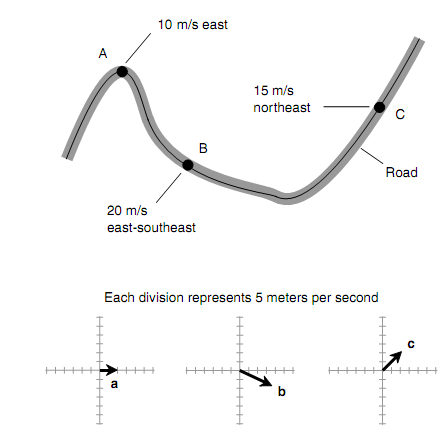How Velocity Is Determined:
Velocity can be measured by using a speedometer in combination with some kind of device which indicates the instantaneous direction of travel. In a car, this may be a magnetic compass. In a strict sense, though, even a speedometer and a compass don't tell the entire story unless you're driving on a flat prairie or plain. In midstate South Dakota, a speedometer and compass can define the instantaneous velocity of your car, but whenever you get into the Black Hills, you'll have to involve a clinometer (a device for measuring the steepness of the grade you are ascending or descending). The 2-dimensional direction components can be symbolized either as compass (azimuth) bearings or as angles measured counter-clockwise with respect to the axis pointing "east." The previous system is preferred by hikers and navigators, while the latter scheme is prefer by theoretical physicists and mathematicians. In figure shown below, the azimuth bearings of vectors a, b, & c are around 90, 120, & 45 degrees, correspondingly. In the mathematical model, they are around 0, -30 (or 330), and 45 degrees, correspondingly.
A 3-dimensional velocity vector consists of a magnitude component and two direction angles. The Celestial latitude and longitude or right ascension and declination are commonly used to symbolize the directions of velocity vectors.

Figure: Velocity vectors a, b, & c for a car at three points (A, B, & C) along a road.